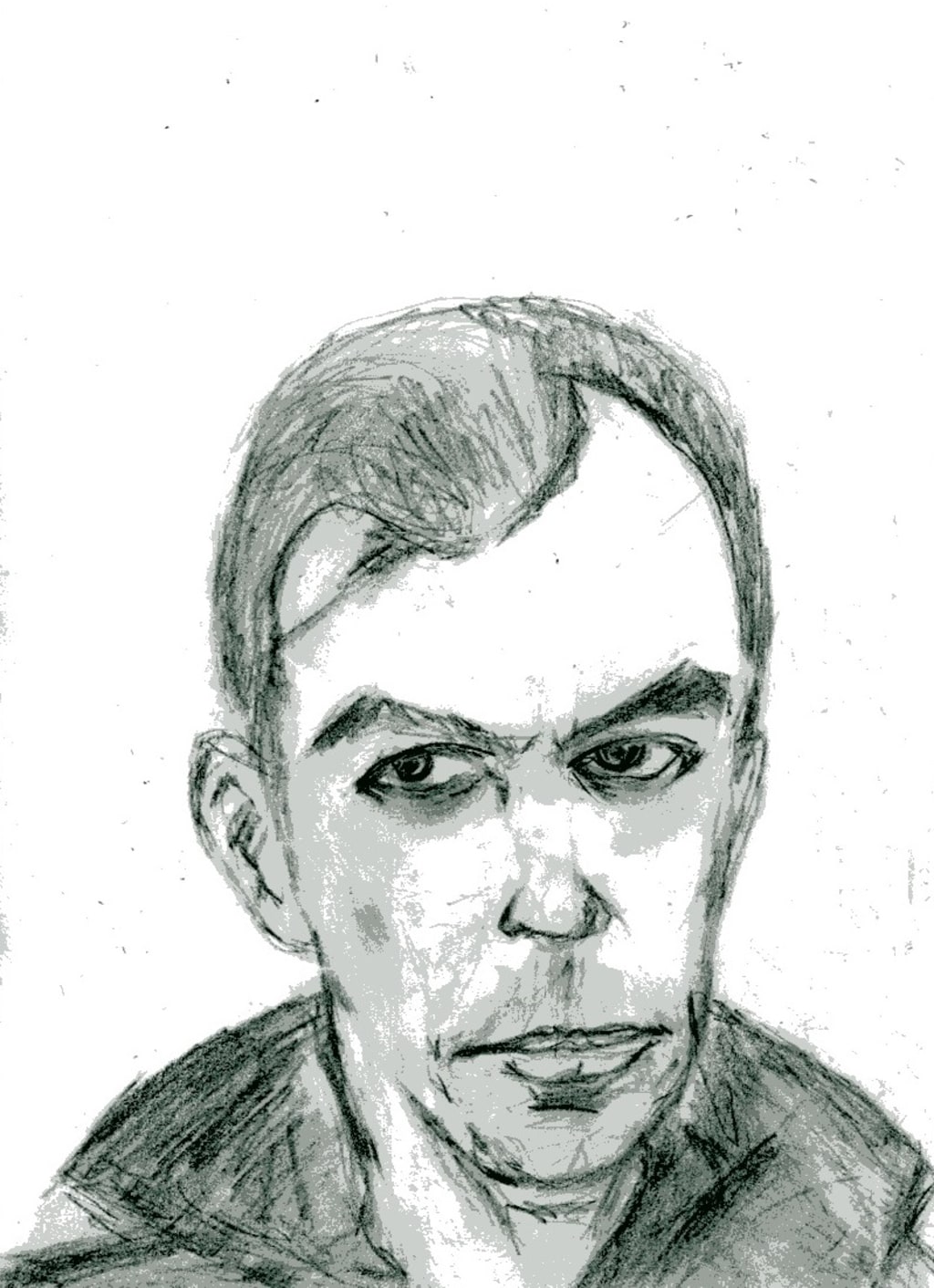
"To none of your printed idols do I bend in acquiescence, and he who saith 'thou shalt' to me, is my mortal foe!" --Ragnar Redbeard, Might is Right (1896)
I'm taking a bit of a risk writing about an artist this controversial. Be that as it may, even if people don't understand, "He must go whom the Devil drives." And here that old proverb is quite apt.
The late Charles Manson once said of him, "Boyd Rice is standing in two circles," and Charlie, for all his schizophrenic and inscrutable babbling, actually knew whereof he spoke. Boyd Rice, for the uninitiated, is a pioneering noise and industrial musician who, since around 1974 or so, has poured forth an ever-evolving anti-musical legacy of churning, droning, grating, oftentimes mesmerizing, but felt to be physically nauseating by SOME --noise. This was a bit before the advent of the first wave of industrial music, when avant-garde and atonal music was the sole provenance of forgotten Dadaist and Futurist composers such as Luigi Russolo. Musique concrete existed, but its appeal was never going to be to more than a handful of strange enthusiasts and those seeking some new expansion of their radical artistic vision. It constituted a largely boring, self-referential manifesto that played with the possibility of what it COULD become.
That began to change in the latter part of the Twentieth Century, when modern dystopian neurosis fueled the anti-establishment shock treatments proffered by punk rock and extreme forms of heavy metal and "industrial rock," as offered up by bands as diverse as Throbbing Gristle, Nine Inch Nails, and Marilyn Manson, all of whom played on millennial fears and modern anxiety in a world that was quickly slipping the gauntlet of reason, becoming one with the machine. The music was a Kafkaesque soundtrack to the dehumanization inherent in post-atomic industrialized Western culture; the obsessions were for all the inverse, ugly, nihilistic aspects of life, be they serial killers, medical casualties, sexual deviance, or dystopian nightmares of mental and psychological manipulation and control.
Boyd Rice began in his youth, fascinated by a strange assortment of mavericks and renegades: Tiny Tim, Anton LaVey, and Charles Manson--those who lived outside the norms of conventional society, but made it their calling. As he once stated, they were "successful not in spite of being weirdos but because they were weird. They made it work for them." Larry Wessel's film Iconoclast (2011) is a nearly four HOUR exploration of the fun and sometimes frightening world of Boyd Rice, a tour inside a man, much hated by many, who see him (for various reasons) as a propagandist for ideologies they fervently, even fanatically oppose. (Boyd is unapologetic in his adoration of the fascist aesthetic; Satanism, Social Darwinism, and even pure misanthropy, and has been photographed with a member of the neo-Nazi American Front in an infamous photo that has often gone before him when he has tried to perform. It should be noted, however, that the photograph in question was done on a lark for a teenage fashion magazine. Boyd declaims ever having been a member of any fascist organization, and eschews "political ideology.")
Here, Rice comes off not as a monstrous purveyor of Far Right ideologies, but as a man who is and was always going to follow his inclinations and inner promptings--his obsessions--to their logical conclusions. One such obsession--a desire to work pranks--to manipulate conventional reality until he could make people what LaVey would term "putty in your hands," saw him presenting a skinned sheep's head to First Lady Betty Ford; feeding the customers at a Taco Bell he worked at inedible food which they tolerated because of the low price; and creating a groundbreaking sonic art form out of the detritus of broken records, working an alchemical transformation that found the "hidden music" between. That is early, beautiful NON, one of the prime influences on my work and the reason why I, myself, started producing experimental recordings so many years ago.
The enfant terrible of Lemon Grove California recounts a childhood where his father's biker friends introduced him to Martin Denny, where he found a strange doorway into the mystical via viewings of "Dark Shadows" and similar occult-themed soap operas, and where the hard-edged early glam rock look and sound found his heart before any sort of avant-garde recordings ever did. Along the way, we are treated to interviews from a surprising array of individuals: Mexican punk rockers, Jewish maverick publishers, chain-smoking artists, and friends and associates who are puzzled that Boyd attracts such polarizing opinions. Knowing and seeing a different side of the ever-evolving artist, they know him to be something other than the two-dimensional cartoon that his opponents draw of him.

We are also treated, at the very beginning of the film, to an exorcism performed by televangelist Bob Larson, who is, in this instance, apparently trying to cast the "demon of lesbianism" from a young woman who begins to sort of jerk around and moan on cue. Bob prays for Boyd and director Wessel, and later Boyd and he discuss religious topics. Larson is quite pleased with Boyd's slow but gradual evolution from spiritual nihilism to a belief in reincarnation--investing reality, as it were, with a deeper meaning than what his previous Darwinistic perspective allowed. Along the way, too, we get Boyd's obsession with Tiki culture, stories from people as diverse as the late Gidget Gein and the late Adam Parfrey, and stories from Boyd about individuals as varied as Rozz Williams, V. Vale, Martin Denny, Tiny Tim, LaVey, Manson, and Cosey Fanni Tutti.
There is nothing in this long film that is ever boring. On the contrary, an outsider could come to it out of even nostalgia, as it takes a look back at a period of the underground that is fast-receding into the distance, a period that saw the birth of alternative rock, the rebirth of punk, and the emergence of countercultural tendrils that helped define the world we live in now, over two decades into the Twenty-first Century. Boyd himself is always fascinating, as he is a study of human contrasts. His gift, his "alchemical working," is to bend pure sound into a doorway, one that creates a new space in the consciousness of the listener--and he has done this on albums such as the untitled all-black "Black Album" (usually just called "Boyd Rice"), Physical Evidence, Blood and Flame, In the Shadow of the Sword, God and Beast, and Children of the Black Sun. It is no accident he became such a compatriot of the late Anton LaVey, so much so that the founder of the Church of Satan pegged him to head the organization upon his death. Boyd is a magician in the same sense that his work casts a literal spell upon the listener, transporting him or her, aurally, to a realm that is either transcendent or awash in the agony of the infernal psyche. And you'd need a map to understand why he goes there, and how you came to follow.
On the whole, you may not LIKE Boyd Rice--and you may have no appreciation of his musical legacy. That is fine. After watching Iconoclast though, you'll not be able to deny he has a firm place in the pantheon of the MOST inscrutable, strange, troubling, difficult, and fascinating artists of the last several decades.
Boyd has spent his life tearing down the conventional norms. A true iconoclast, the documentary on his life is aptly named. The very first minutes of the film reveal the extent of a young female fan's devotion to him: she has used a dagger to carve the word NON (the name of his long-running musical project) over her exposed pudenda. Others, such as the protestors outside a club he is slated to perform at, could probably tear him to pieces. Boyd goes out to speak with them calmly, and rationally; he comes off as far more level-headed than they do.
But we're not here to say he's not controversial, or that what he does is for everyone. He encompasses the dualistic aspects of dark and light, a man that can obsess over Sixties girl groups, Bobbie Sherman lunch boxes, and Gabrielle D'Annunzio and never skip a beat. But, what would you expect from a man that is always and forever, "standing in two circles?"
Post Script: It has come to our attention that Larry Wessel, the maker of this documentary, no longer is on speaking terms apparently with Boyd Rice, or at least they parted ways acrimoniously on the completion of this film. The reasons given are a little unclear, but I am uncertain and assuming that that has not changed in the intervening years. Wessel has described Rice as a "lonely, cold-hearted, pretentious, hypocritical, sociopath." That's a subjective opinion, but even if it is to a great degree true, it doesn't alter my estimation of him as a creative artist, one of the most fascinating and unconventional provocateurs to emerge from the underground milieu. So be it.
NOTE: The trailer for ICONOCLAST is "age-restricted" on YouTube. I'm not certain if quick, brief flashes of nudity in it would be in violation of Vocal's Terms of Service, and I don't want to take the risk of linking it here. Instead, I have elected to feature a short interview clip with Rice from the time of the release of his album "Back to Mono" (2012).
About the Creator
Tom Baker
Author of Haunted Indianapolis, Indiana Ghost Folklore, Midwest Maniacs, Midwest UFOs and Beyond, Scary Urban Legends, 50 Famous Fables and Folk Tales, and Notorious Crimes of the Upper Midwest.: http://tombakerbooks.weebly.com






Comments (1)
You piqued my interest . Thanks